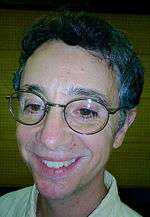Julio Gea-Banacloche
| Julio Gea-Banacloche | |
|---|---|
 | |
| Born |
1957 Seville, Spain |
| Residence | Arkansas, U.S. |
| Citizenship | American |
| Fields | Physicist |
| Institutions | University of Arkansas |
| Alma mater |
University of New Mexico Universidad Autonoma de Madrid |
| Doctoral advisor | Marlan O. Scully |
| Doctoral students |
G. A. Finney Tim C. Burt E. A. Hach Michael Teplitsky Juan D. Serna Shabnam Siddiqui |
| Known for | Energy bound on quantum computation |
Julio Gea-Banacloche (born 1957) is Professor of Physics and currently the Head of Department of Physics at the University of Arkansas. He is notable for his contribution to the field of quantum information, where he has shown that the quantum mechanical nature of the fields used to manipulate the quantum information carriers (qubits) themselves might lead to unpredictable errors in the performance of the quantum logical operations. The lower bound on the size of these errors can be made smaller by increasing the energy of the control system. This has led Gea-Banacloche to predict a minimum energy requirement for quantum computation, which has given rise to some controversy.[1]
Education
He received his BS from Universidad Autonoma de Madrid, 1979; and obtained his PhD under Marlan O. Scully, 1985, on free-electron lasers, from the University of New Mexico with a thesis entitled: Quantum Theory of the Free-Electron Laser.
Career
In 1985-87, he served as a Research Associate, Max Planck Institute for Quantum Optics. In 1988-90 he was a Staff Scientist, Instituto de Optica, Madrid, Spain. In 1990, he joined the University of Arkansas. He is an associate editor of Physical Review A and Fellow of the American Physical Society. He has carried out theoretical work in laser physics, quantum optics, and quantum information.
See also
Notes
External links
- Gea-Banacloche's homepage
- Gea-Banacloche's achievements
- Gea-Banacloche on Qwiki
- Gea-Banacloche's math genealogy
- Related work: J. Gea-Banacloche, L.B. Kish, Comparison of Energy requirements for Classical and Quantum Information Processing, Fluctuation and Noise Lett. 3 (2003) C3-C6.